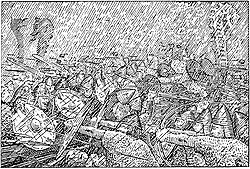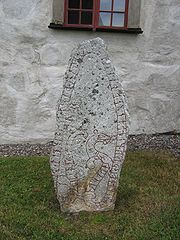
Thorkell the High
Encyclopedia


Swedish language
Swedish is a North Germanic language, spoken by approximately 10 million people, predominantly in Sweden and parts of Finland, especially along its coast and on the Åland islands. It is largely mutually intelligible with Norwegian and Danish...
; Torkel Höge: Danish
Danish language
Danish is a North Germanic language spoken by around six million people, principally in the country of Denmark. It is also spoken by 50,000 Germans of Danish ethnicity in the northern parts of Schleswig-Holstein, Germany, where it holds the status of minority language...
: Torkild den Høje) was a Jomsviking, a son of the Scanian chieftain Strut-Harald
Strut-Harald
Strut-Harald was a semi-legendary jarl or petty king who ruled over the Danish territory of Scania during the late 10th century CE...
, a brother of Jarl Sigvaldi, commander of the Jomvikings and the legendary stronghold, mythical Jomsborg
Jomsborg
Jomsborg was a semi-legendary Viking stronghold at the southern coast of the Baltic Sea , that existed between the 960s and 1043. Its inhabitants are known as Jomsvikings. Jomsborg's exact location has not yet been established, though it is maintained that Jomsborg was somewhere on the islands of...
, on the Island of Wollin, while himself a notable lord.
Thorkell took part in the Battle of Hjörungavágr
Battle of Hjörungavágr
The Battle of Hjörungavágr is a semi-legendary naval battle that took place in the late 10th century between the Jarls of Lade and a Danish invasion fleet led by the fabled Jomsvikings...
in 986 and in the Battle of Swold in 1000. He attacked England
England
England is a country that is part of the United Kingdom. It shares land borders with Scotland to the north and Wales to the west; the Irish Sea is to the north west, the Celtic Sea to the south west, with the North Sea to the east and the English Channel to the south separating it from continental...
in 1010, landing near Ipswich on the shores of the river Orwell at Nacton with a large army, defeating the local army sent from Ipswich. He was eventually paid an unusually large Danegeld
Danegeld
The Danegeld was a tax raised to pay tribute to the Viking raiders to save a land from being ravaged. It was called the geld or gafol in eleventh-century sources; the term Danegeld did not appear until the early twelfth century...
in 1011.
In 1012, Thorkell's men took Archbishop Alphege
Alphege
Ælfheah , officially remembered by the name Alphege within some churches, and also called Elphege, Alfege, or Godwine, was an Anglo-Saxon Bishop of Winchester, later Archbishop of Canterbury. He became an anchorite before being elected abbot of Bath Abbey...
hostage, who had previously been instrumental in negotiating danegeld payments. It is said that Alphege refused to be exchanged for ransom organised by Eadric Streona
Eadric Streona
Eadric Streona was an ealdorman of the English Mercians. His name a loose translation of the Anglo-Saxon "the Grasper." Streona is historically regarded as the greatest traitor of the Anglo-Saxon period in English history....
as he did not wish to further impoverish his countrymen. As a consequence of this he was murdered by Thorkell's men during a drunken feast. Sensing that he was losing control over his men, Thorkell and his loyalists defected and he and his men entered into the service of king Ethelred the Unready
Ethelred the Unready
Æthelred the Unready, or Æthelred II , was king of England . He was son of King Edgar and Queen Ælfthryth. Æthelred was only about 10 when his half-brother Edward was murdered...
, whom they fought under in 1013 against the invasion of king Sweyn Forkbeard and his son Cnut
Canute the Great
Cnut the Great , also known as Canute, was a king of Denmark, England, Norway and parts of Sweden. Though after the death of his heirs within a decade of his own and the Norman conquest of England in 1066, his legacy was largely lost to history, historian Norman F...
. After the death of Sweyn, and the English attacks on the Danish invaders which drove his son to abandon the conquest, Ethelred's forces were turned against the Jomsvikings in his service. Thorkell's brother Henning was killed, and he went back to Denmark, with a score to settle in England. He was to return with the future king, in 1015, and the invasion's success meant he was proclaimed to be the Jarl of East Anglia
East Anglia
East Anglia is a traditional name for a region of eastern England, named after an ancient Anglo-Saxon kingdom, the Kingdom of the East Angles. The Angles took their name from their homeland Angeln, in northern Germany. East Anglia initially consisted of Norfolk and Suffolk, but upon the marriage of...
, in 1017, after the coronation of the Viking king of England. An explanation for Cnut the Great's acceptance of Thorkell's allegiance, not to mention his military prowess, may be that he was in fact his childhood mentor, and the Jomsvikings were also of special worth to Cnut. He himself held a score against the men responsible for the betrayal of oaths of allegiance given by the English nobles after his father Forkbeard's conquest. If it was Thorkell's men who taught Cnut to fight his battles, such bonds as these were surely hard broken, even with opposition in war.
In 1021, though, Jarl Thorkell fell out with king Cnut, and had to make himself scarce and went to Denmark. This appears to have been as a result of a trial of his wife, who was found guilty of poisoning his son by his first marriage, with the help of a witch. Thorkell had sworn to her innocence and consequently lost face. He was soon reconciled with Canute again, who proclaimed him Jarl once more, of Denmark, although he seems to disappear, in 1023, as there is no mention of him after this point. It may be he was simply too old for any more conflict, and the final years of his life spent at court, yet with no military commands. It may also be that he was cast out of the kingdom, to return to Jomsborg, or Scane, and lived the rest of his days as a wayward old soldier. Equally, he might have been dead soon after he was made Jarl of Denmark, and the causes either natural or malevolent.
While we are sure Thorkell is undoubtedly a real historical figure, his career, especially its early part, is steeped in legendary associations with the mysterious Jomsvikings, which too often distract and distort from the facts of his life.
In fiction
Thorkell the Tall appears as a character in the Japanese manga Vinland SagaVinland Saga (manga)
is a Japanese historical manga series written and drawn by award-winning manga author Makoto Yukimura. The series is published by Kodansha, and was first serialized in the youth-targeted Weekly Shōnen Magazine before moving to the monthly manga magazine Afternoon, aimed at younger adult men...
, a fictionalized account of the era. His character is first seen defending London from the Danish Invasion, but he later aligns himself with Prince Canute in an effort to dethrone Sweyn Forkbeard.

